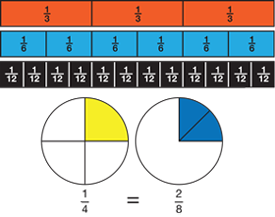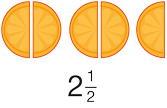Students practice estimating, adding, and subtracting fractions including those with unlike denominators and mixed numbers. Students choose to play either Circle Duets to practice adding fractions or the Closest To game to practice estimation and subtraction.
Content in this Lesson
- Finding equivalent fractions using tools (e.g., area models, number lines) and multiplication and division strategies [E1].
- Representing addition and subtraction of fractions with area models, number lines, and number sentences [E3].
- Solving word problems involving addition and subtraction of fractions [E5].
- Adding and subtract fractions including those with unlike denominators using area models and paper-and-pencil methods [E8].
- Estimating sums and differences of fractions using benchmarks and mental math strategies [E9].
- Finding common denominators and using them to add and subtract
fractions [E10]. - Choosing appropriately from among estimation and computation
strategies [E7]. - Knowing what information is important in a problem [MPE1].
- Finding an estimation, addition, or subtraction strategy [MPE2].
- Estimating sums and differences to check answers for reasonableness [MPE3].
Daily Practice and Problems S–V
Assessment in this Lesson
| Assessment | Expectation Assessed | Math Practices Expectation Assessed |
|---|---|---|
|
Find Fraction Sums and Differences |
|
|
|
Find Fraction Sums and Differences |
|
|














 and
and  since 15 is divisible by both 3 and 5.
since 15 is divisible by both 3 and 5.  and
and  .
. ,
, ,
, are equivalent to each other, and
are equivalent to each other, and  and
and  are equivalent to each other.
are equivalent to each other.
 .
.